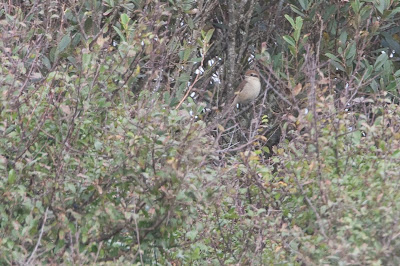Although I missed out on Hurricane Bill's spectacular at Pendeen, due to work commitments, I did manage an hour and half off Lizard Point yesterday late afternoon. Things started off well when a Puffin, almost the first bird I saw, flew east. Less than a minute later a Sooty Shearwater flew west suggesting I was in for a good un. I soon scored another Sooty, but was distracted by a fishing boat chugging east with large numbers of gulls in its wake. I thought I saw a Sabine's Gull in amongts the gulls, but was distracted for a few minutes by several petrels also in the wake, one of which appeared not to have a white underwing stripe - too distant to be sure. Any scouring back through the gulls, I noticed there were actually two juv Sabine's Gulls. Around the same time. two more Sooty Shearwaters flew past. A good haul for 20 minutes! A texted Andy and Tony, neither of whome could make it down, but actually things got quieter. The next hour or so produced a steady trickle of Manxies, Fulmars and Gannets, 1 Balearic Shearwater (W), another Sooty Shearwater (W), 1 Bonxie (E) and few more petrels, most of whch were stormies, the rest of which were unidentified. Last decent sighting of the day was an Ocean Sunfish flapping its dorsal as it drifted slowly past.
I've been out birding a a few times over the last couple of weeks, including a trip back to my old stomping grounds in Norfolks, but aside from Garganey (Cantley Sugar Beet Lagoons), Spoonbill (the long resident bird at Cley) and Green & Curlew Sands (Cley & Rushhill), I didn't see much and havent updated the blog. I should have really updated it for Pectoral Sandpiper though. Late afternoon on the 14th of August, after a scouring the Marazion reedbeds for Aquatic Warbler & Spotted Crake to no avail, saw me scanning the waders on Marazion Beach. As I walked towards the causeway to St Michaels Mount, I noticed bird which stood out from the Dunlin by being slightly taller and having greenish legs. A closer look revealed the classic pale saddle stripes, clean white belly and breast streaking tapering to a neat point. A Pec Sand! Rather early for a juvenile. After watching it for about 10 minutes and taking a few field notes I decided to text a few locals and ring Birdguides. While on the phone, a dog walker scared all the waders off, and unfortunately, although I saw where most of them went, I lost track of the Pec Sand. I walked down to where most of the waders were. What followed, is an embarrassing incident - one which I’d rather forget about, and one which I could attribute to the fading light, but really there’s no excuse! Just as Dave Parker was arriving, I located the group of dunlin that were flushed and immediately noticed one with clean white underparts and fairly clear pale saddle markings. I thought I’d got back on the Pec, and informed him it was there. He looked at the bird more closely in my scope and said he could only see Dunlin. I looked at it more closely and could only see Dunlin too! I thought the bird had moved in the mean time, but it hadn’t. I’d mistaken the Dunlin for a Pec Sand. I actually began questioning whether I’d completely cocked things up first time round. Then I remembered the legs and no – the bird I’d first seen definitely had noticeably greenish-yellow legs and the “Dunlin” definitely had dark legs. Fortuitously both my notes and the extremely poor snap I took through my phone confirm this, along with some pretty obvious structural differences (I was quite relieved when I got home and double checked though!) I set of in search of the bird on other parts of the beach, but in the event, the fading light defeated a relocation.
 First found by Tony Blunden (involved in the Brown that was on the Scillies). Managed to get down with Thor Veen who took these photos. Sorry about the quality - the bird was distant and the photos have been heavily cropped. Click on photos for a larger version
First found by Tony Blunden (involved in the Brown that was on the Scillies). Managed to get down with Thor Veen who took these photos. Sorry about the quality - the bird was distant and the photos have been heavily cropped. Click on photos for a larger version







